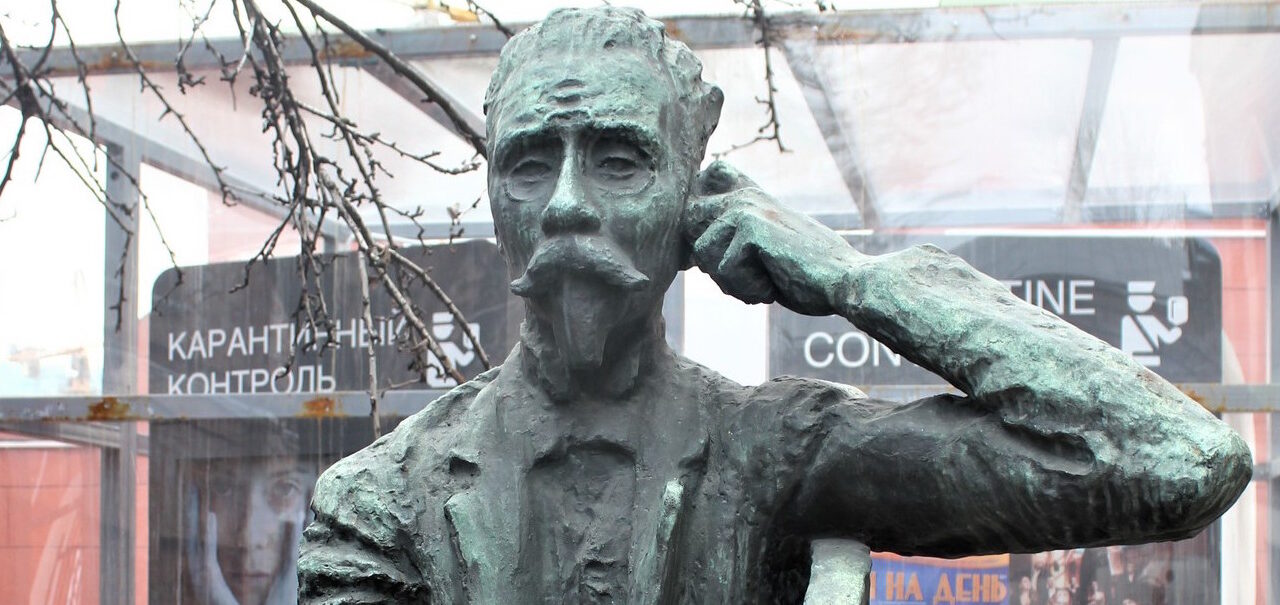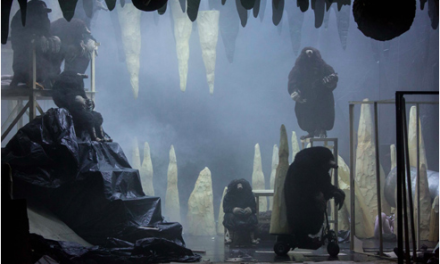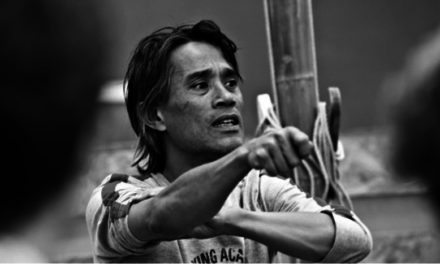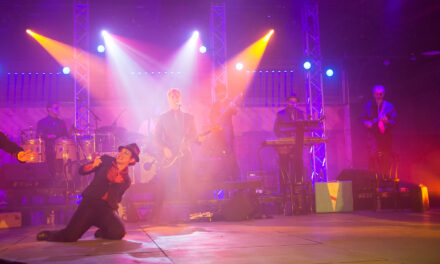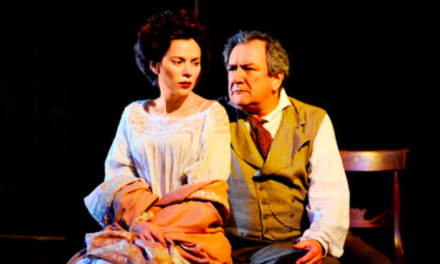An 1890s red brick, neo-gothic mansion, situated on a busy intersection of central Moscow, houses one of the largest and richest world collections—including visual art, a library, archives, and more—dedicated to the history of theater. Founded in 1894 by Aleksei Bakhrushin, a Russian entrepreneur, collector, and theater enthusiast, as a small private museum, it evolved in a major museum visited by hundreds of thousands of people every year—the State Central Theatrical Museum (GTsTM after its Russian acronym), named after its founder, A.A. Bakhrushin.
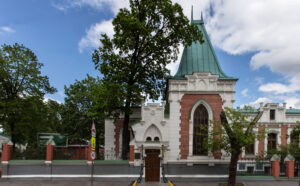
GTsTM building in Moscow, facade.
My own first visit to the museum was in 1992, when I, then a third-year history student, was assigned to do a document-cataloging project. My task was to catalog a collection on the history of the Moscow Yiddish theater (GOSET) at the GTsTM archives. Then and there, I made my first archival discovery—a manuscript of a play, long considered lost, by Solomon Mikhoels, the GOSET’s major star. Since then, the GTsTM has been a special place for me. The museum has no items related to Jewish theater on permanent display, however, in 2015, the GTsTM organized a unique exhibition on the origins of Jewish theater in 1920s Moscow, including the Yiddish GOSET and the Hebrew Habima, now the National Theater of Israel. Dmitrii Rodionov, the Head of the Museum, is himself fascinated by Jewish theater and especially, Solomon Mikhoels. It was therefore not a coincidence that I met Dmitrii at the online memorial symposium celebrating Mikhoels. I asked Dmitrii Rodionov for an interview, so that TheTheatreTimes.com readers could learn more about the GTsTM.
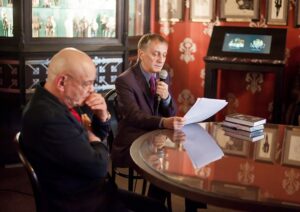
Dmitrii Rodionov (right) and Konstantin Raikin (actor, director and head of the Moscow Satyricon Theatre) at the GTsTM event.
What exactly is the State Central Theatrical Museum? A collection of theater-related artifacts and ephemera? Or more?
Definitely more. Basically, among the 1.5 million items of its holdings there are original set designs and costumes by leading stage designers for hundreds of theatrical performances across the former Russian Empire and the USSR, thousands of rare playbills and posters, the personal archives of leading Russian actors and directors, rare books and periodicals on theatrical art, paintings, sculpture, and other pieces of art. Moreover, in addition to the main building, the GTsTM maintains 9 Moscow and 3 provincial branches in Ul’ianovsk, Zaraisk and Nizhnii Novgorod. The Moscow branches include residences, now museums (most of them accessible to the public), of leading Russian actors, directors, playwrights, and set designers such as Mariia Ermolova, Mikhail Shchepkin, Aleksandr Ostrovskii, Galina Ulanova, Vsevolod Meyerhold and others. Currently, the city of Moscow is sponsoring a major renovation and expansion of the GTsTM main building.
In my experience, the GTsTM manuscript division is a treasure trove, on par with the Russian State Archive for Literature and Art, the country’s biggest collection of theater-related archival material. What do you have?
Yes, our manuscript division has more than 200,000 unique documents spanning 300 years of Russian theater history, from the late eighteenth to the early twenty-first century, starting with the personal archives of the first professional Russian actors and directors, brothers Fedor and Grigorii Volkov. We also have the archives of the major nineteenth century Russian theaters, such as the Maly Theater of Moscow and the Aleksandrinskii Theater of St. Petersburg, including memorabilia of the great Russian actresses—Mariia Ermolova, Mariia Savina, and Vera Komissarzhevskaia. In addition, there are sizeable archival collections of the less celebrated but very important private theatrical enterprises in the Russian capital cities and provinces, run by Konstantin Nezlobin, Fedor Korsh, Anna Brenko, and others. Archival collections on the history of the Russian opera and ballet are represented by artifacts from the leading Russian music composers such as Mikhail Glinka, Petr Tchaikovsky, and Igor Stravinsky, opera singers such as Leonid Sobinov and Fedor Chaliapin, choreographers Aleksandr Gorskii of the Moscow Bolshoi Theater and Marius Petipa of the St. Petersburg Mariinsky Ballet. We have collections from the most important modernist and avant-garde playwrights and directors who reshaped Russian and world theater at the turn of the twentieth century—Anton Chekhov, Konstantin Stanislavsky, Evgenii Vakhtangov, Aleksandr Tairov, and Vsevolod Meyerhold. The years of World War II and the late Soviet period (1941-1991) are represented by personal archives, including correspondence, diaries, autobiographies, and more, of the leading Soviet theater and movie stars—Nikolai Cherkasov, Evgenii Leonov, Andrei Mironov, Oleg Dal, Anatolii Papanov and others; and by a unique collection of the wartime Red Army’s frontline theaters and “performing brigades.”
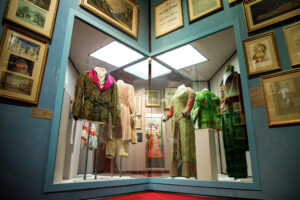
Permanent display at the GTsTM.
Does the Museum maintain connections with “non-historical,” i.e. actual working theaters? What role does the Museum play in the Russian theater of today?
The Museum is actively involved in Russia’s current theatrical life. As a cultural institution, we seek a close connection with living Russian theater and active collaboration with its creators. The GTsTM academic board includes leading theater directors, producers, actors, and scholars of theater. We organize and host lectures and classes for young actors and directors taught by local and visiting experts. We run several programs supporting Russian theaters, raising public awareness about theater, and collecting materials on theater history. These include:
- The Annual Bakhrushin Theater Festival for children.
- The “Teatral’nyi roman” (Theater Novel) Prize for literature on theater.
- The National Online Portal of Russian Theatrical Museums and Archives in Russia and abroad.
- The program of collecting historical materials, including archives and artifacts, on the history of Russian theater.
The Museum’s collaboration with and support of Russian theaters goes parallel with the documenting and archiving, in real time, of the ongoing theatrical process, and preserving it for the next generations. This is our principal mission.
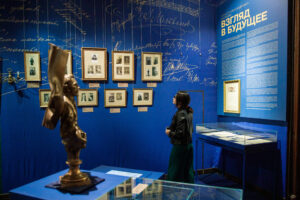
Exhibition at the GTsTM.
Museums are brick-and-mortar institutions meant for physical visitors and visual encounters with select exhibits within the curated space. How did the COVID-19 pandemic affect the GTsTM? Did you go virtual?
Yes, we did. We have maintained a virtual presence for the past few years, but the recent year was a real turning point. In addition to reaching out to the public through social media and internet broadcasting of our events, the museum is making more of its collections accessible online, creating online video tours, and online exhibitions. As a result, GTsTM website traffic increased to more than 1 million visitors as of the past year. We welcome all—theater enthusiasts and professionals—to visit us and to make use of our rich collections.
This post was written by the author in their personal capacity.The opinions expressed in this article are the author’s own and do not reflect the view of The Theatre Times, their staff or collaborators.
This post was written by Vassili Schedrin.
The views expressed here belong to the author and do not necessarily reflect our views and opinions.

